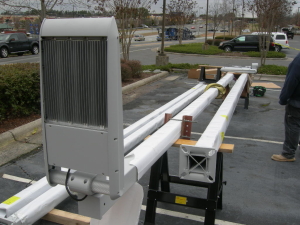(With contributions from David Whitney, Atlantec Engineers)
When Architects and Engineers sing their own praises and pat themselves on the back about energy conservation successes, it most often focuses on new construction. It is fairly easy (and mandatory under some Energy Codes) to do the “right thing” with new buildings. Energy Star, USGBC’s LEED program, Green Globes and others encourage the readily-achievable energy-efficient NEW building.
What tends to get lost in the discussion is what to do about the 80 billion square feet of commercial space currently in existence in the United States. Building owners often view energy upgrades to existing buildings as expensive and disruptive. But, with advances in technology, payback periods shortening, and many improvements that can now be made with very little disruption; it may be time to consider improvements to your building.
“Buildings account for nearly 40 percent of the energy consumed in the United States. Typical commercial buildings use, on average, twice the energy of efficient buildings and three to four times that of the nation’s highest performing buildings. With roughly 80 billion square feet of existing commercial space in the United States alone, updating existing buildings is a critical pathway to meeting climate and energy policy goals, utility efficiency targets and real estate objectives.”
– Existing Buildings SMART Scale Program
A few resources to check out…
A Search for Deep Energy Savings in Existing Buildings
This two-phase set of work was conducted as part of the Northwest Energy Efficiency Alliance (NEEA) regional Existing Building Renewal (EBR) initiative to accelerate commercial market adoption of deep, integrated energy-efficient retrofits. A Meta Report builds on phase 1 work, which developed an initial list of 50 existing building projects showing improvement of 30%+ energy savings from two or more efficiency measures in the past 10 years. Ultimately, 11 of those buildings projects were investigated further with extensive research into the “story” of the retrofit, including data on measured energy use and financial information. View the report HERE.
The NEEA Study of Existing Building Energy Efficiency Renewals ‘Executive Summary’ completed August 15, 2011 provides a comprehensive overview and deep dive into this subject, outlining in-detail how through a variety of relatively straight-forward efforts, existing commercial buildings can realize drastic energy consumption reductions. Below are six categories as outlined by this study that can be implemented as part of Building Improvement/Retrofit Management Plan for reducing existing building energy consumption:
- Plug Load Management: smart power strips, work space control systems and power management software. Click HERE.
- High-Efficiency lighting : Fluorescent Lamps, HID Lamps, LED Lamps. Click HERE. (Editor’s note: This article is a bit dated. It states the LED technology is still in its infancy which is not true at all. LED lights are replacing most HID sources for parking, garage, and exterior building lights. LED fixtures offer a higher lumen to watt ratio, better color rendering, and longer life than their HID counterparts. LED can lights are rapidly replacing incandescent and compact fluorescent can lights. Retrofit kits are available on-line and at most hardware stores Lowes, Home Depot etc.LED lights are also competing to replace many traditional fluorescent light fixtures as well. LED options are available for industrial fluorescent fixtures, lay-in fluorescent, linear fixtures, as well as high bay.)
- Daylighting: new glazing, shading systems, daylight harvesting, reduced dependence on artificial light. Click HERE.
- Lighting & Ventilation Controls: advanced lighting controls, passive ventilation, chilled beams, radiant heating/cooling, plug load controls. Click HERE and HERE.
- High-Efficiency Heating: radiant heating/cooling. Click HERE.
- Ventilation & Air-Conditioning Equipment: thermostats, run-times, alarm & fault management, system efficiency. Click HERE.
Not all energy-efficient improvements NEED to be expensive and disruptive. Many are readily-achievable with shorter paybacks than previously experienced. The massive amount of existing building stock in the U.S. needs to be addressed, for many different reasons, but not the least of which is saving energy (and money).


